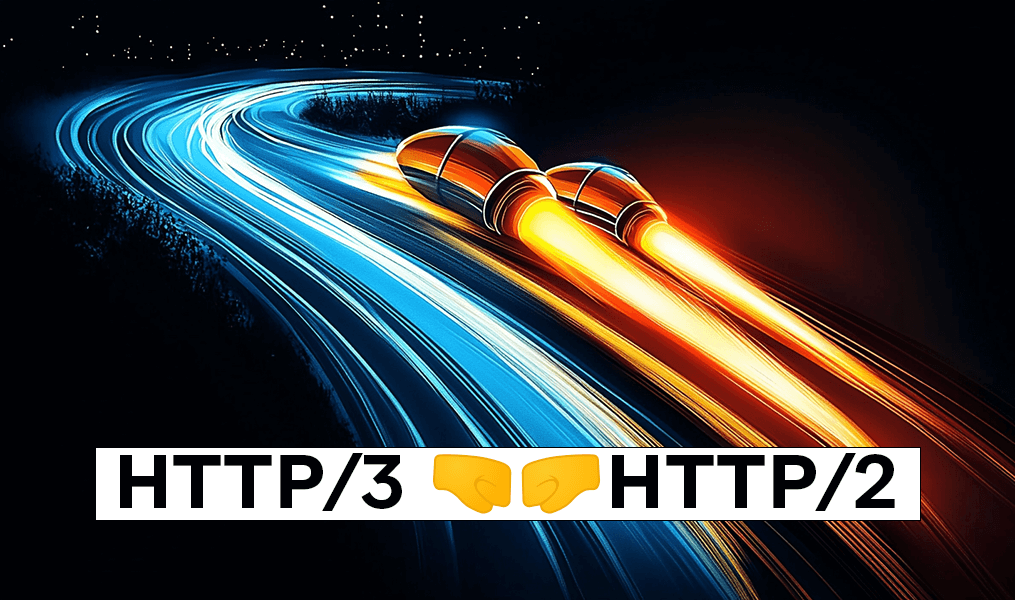HTTP/3 vs HTTP/2: Key Advantages of the New Protocol for the Modern Web
07 October, 2024HTTP/3 HTTP/2: the main advantages of a new protocol for the modern web
Each year, the demands for speed , stability , and security in web connections increase, as modern users expect instant page loading and secure data transmission. The HTTP protocol , which serves as the foundation for data transmission on the internet, also continues to evolve to meet these requirements. For a long time, HTTP/2 was considered the best standard for fast loading of web resources, but with the introduction of HTTP/3, the industry has gained a new tool to enhance web page performance.
HTTP/3 is the next stage in the evolution of the HTTP protocol, based on the QUIC protocol developed by Google. This new standard was created to overcome the limitations of HTTP/2, such as delays caused by connection issues and instability during data transmission in unstable networks. In this article, we’ll discuss the main advantages of HTTP/3 over HTTP/2 and explain why switching to the new protocol is becoming a beneficial solution for most modern web resources.
Image from: https://www.cloudpanel.io/blog/http3-vs-http2/
What are HTTP/2 and HTTP/3?
HTTP/2
HTTP/2 was a significant step forward compared to HTTP/1.1. It solved a number of problems from the previous version, enabling faster data transmission and reduced delays through multiplexing. One of the main advantages of HTTP/2 is multiplexing — the ability to send multiple requests and receive responses simultaneously over a single TCP connection. However, the TCP protocol that HTTP/2 relies on has several limitations, especially in cases of unstable connections .
HTTP/3
HTTP/3 is based on the QUIC protocol, developed to enhance speed and reliability, even in conditions of high latency or network instability. QUIC uses UDP, allowing faster connection setup and resilience to disconnections, reducing delays and improving the overall performance of websites . Instead of re-establishing the connection in case of packet loss, as TCP does, HTTP/3 continues to operate, reducing load times and ensuring an uninterrupted user experience.
Key Advantages of HTTP/3 over HTTP/2
Increased Load Speed
One of the biggest advantages of HTTP/3 is its significant reduction of latency, thanks to QUIC. The QUIC protocol uses faster connections over UDP, which helps avoid the traditional delays typical of TCP. This is especially important for mobile users , as during network switching (e.g., from Wi-Fi to mobile data), HTTP/3 remains stable and doesn’t require re-establishing the connection.
Connection Optimization
HTTP/3 helps avoid the problem known as head-of-line blocking — a situation where a delay in one packet halts the entire data transmission in the stream. This was a major limitation of HTTP/2, as TCP connections couldn’t bypass this issue, significantly slowing down loading . QUIC allows packets to be transmitted independently, making the connection more stable and allowing for faster information loading.
Enhanced Security
One of the defining characteristics of HTTP/3 is protocol-level encryption . QUIC has built-in encryption, which makes the protocol more secure and reliable. While HTTP/2 also supports encryption, HTTP/3 integrates it directly into the connection structure, enhancing protection against attacks and speeding up performance. Learn more about the QUIC protocol on the official IETF website.
Performance on Mobile Devices
HTTP/3 performs better with low-stability networks , such as mobile ones. Thanks to QUIC, this protocol avoids interruptions during network switching, keeping the connection active, which is especially important for smartphone users who often connect to different networks.
Support for Concurrent Connections
HTTP/3 can handle multiple concurrent connections without losing efficiency, ensuring even data distribution and stable operation. This is important for modern websites that use a large number of resources and multimedia elements, as it reduces the risk of delays. Find more information about HTTP/3 on MDN.
Should You Switch to the New Protocol?
With the advantages HTTP/3 offers in terms of speed and stability, this protocol is becoming beneficial for most modern websites, especially those focused on large volumes of users or media content . Companies that have already adopted HTTP/3, such as Google, Facebook, and Cloudflare, report reduced latency and improved service performance, especially in mobile networks.
Conclusion
HTTP/3 offers significant benefits over HTTP/2 thanks to increased speed, stability, and connection security, making it appealing for modern web resources. Switching to HTTP/3 can greatly improve the user experience, especially on mobile devices and high-traffic sites . It’s expected that HTTP/3 will become the new standard for most websites in the future, providing even faster and more secure connections.
If you’re interested in ensuring fast loading of your site and improving its position in search engines, read our articles in the SEO section and learn more about the importance of website speed optimization.


